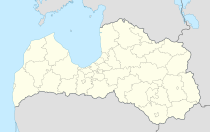Rēzekne
| Rēzekne ( German : Rositten) | ||
|---|---|---|
 |
|
|
| Basic data | ||
| State : |
|
|
| Landscape: | Latgale ( Latvian : Latgale ) | |
| Administrative district : | Republic-city of Rēzekne | |
| Coordinates : | 56 ° 30 ' N , 27 ° 20' E | |
| Residents : | 30,538 (Jul 1, 2018) | |
| Area : | 17.48 km² | |
| Population density : | 1,747 inhabitants per km² | |
| Height : | 158 m | |
| City law: | since 1773 | |
| Website: | www.rezekne.lv | |
| Post Code: | 4601-4606 | |
| ISO code: | ||
| Castle hill and remains of the castle | ||
Rezekne ( German Rositten , Russian Резекне until 1917 Режица Reschiza ) is a town in the countryside Latgale ( Latvian Latgale ), to the east of Latvia . Rēzekne is located at the junction of the roads and railway lines Moscow - Riga and Saint Petersburg - Warsaw and is one of the nine Republic cities of Latvia. In 2018, Rēzekne had 30,538 inhabitants.
history
A Latgalian castle stood in Rēzekne from the 9th century. Before the arrival of the Crusaders, the place belonged to Jersika and was mentioned in the Novgorod Chronicle as "Lotigolu". From 1209 the local Prince Visvaldis ruled as a vassal of Bishop Albert . From 1224 the area fell entirely to the Bishop of Riga , who gave it to the Livonian Order in 1239 . In 1285 a brick castle was built, which is mentioned in documents under the name Rositten. In the state of the order the city was the center of the Bailiwick of Rositten. In the 14th and 15th centuries, the area was devastated by the armies of Novgorod and Pskov . From 1558 the bailiwick was pledged to Poland-Lithuania . In 1582 it became part of the Duchy of Livonia . The town and castle were occupied several times by foreign armies: from 1577 to 1579 and from 1654 to 1656 by Russian troops, in 1601, from 1625 to 1626 and from 1656 to 1660 by the Swedes. From 1660 until the partition of Poland in 1772 , the city belonged to the Livonia Voivodeship and then as Reschiza (Режица) to the Russian Empire . In the 19th century Reshitsa was the seat of a Ujesd in the Vitebsk Governorate . With the construction of the Saint Petersburg - Warsaw and Moscow - Riga railways , the city became a transport hub and industrial center. The population grew to 23,000 people by 1914. At the 1897 census, 54% of the population of Rēzekne were Jews .
The first Congress of Latgalian Latvians was held in Rēzekne in the spring of 1917. After the October Revolution of 1917, the Bolsheviks took power. In February 1918 the German Imperial Army marched in before the Bolsheviks returned in December. In January 1919, Rēzekne was finally recaptured by the Baltic State Armed Forces and part of independent Latvia.
In 1920 Rēzekne had only 5,000 inhabitants. In 1939 there were 13,300 residents in the city. In 1940 the Red Army marched in and in 1941 the Wehrmacht . Much of the city was destroyed in the fighting in late July 1944.
After the war, Rēzekne was rebuilt with an emphasis on industrial development. The subsequent influx of Russians and other ethnic groups from the Soviet Union meant that they now constitute the majority in the city.
Rēzekne today

- Along with Daugavpils, the city is the cultural center of Latgale. The Rēzekne University has existed since 1993. The multifunctional center "GORS", opened in 2013, houses two of the most modern concert halls in the Baltic States.
- Some historical buildings have been preserved in “Latgale Street”, for example the “Ērgļi Pharmacy” built in 1882.
- The statue of Latgales Māra by Leons Tomašickis in the city is dedicated to Latvian independence. Destroyed during the Soviet Union, it was rebuilt in 1992.
- In Rēzekne there is a memorial for the Jewish residents who were murdered by the Germans during World War II . A memorial plaque on the wall of the former prison commemorates the Audriņi massacre .
sons and daughters of the town
- Juri Tynyanow (1894–1943), Russian writer and literary scholar
- Ivan Sawoloko (1897–1984), Russian ethnographer, author, teacher
- Friedrich Ermler (1898–1967), Soviet actor and director
- Vladimirs Arsentjevs (* 1951), graphic artist, creator of the emblem of the 1980 Summer Olympics in Moscow
- Jānis Urbanovičs (* 1959), politician
- Ilze Viņķele (* 1971), politician
- Iveta Apkalna (* 1976), organist
- Kristīne Opolais (* 1979), soprano
- Ilmārs Starostīts (* 1979), Latvian chess player
- Aiga Grabuste (* 1988), long jumper and heptathlete
- Žanna Juškāne (* 1989), biathlete
- Gunta Latiševa-Čudare (* 1995), sprinter
The city name in other languages
- Latvian from 1893 to 1917: Riejitsa
- Latgalian : Řezné ,
- German : Rositten
- Russian : Резекне (Resekne) , until 1893: Розиттен (Rositten) , 1893 to 1917: Режица (Reschiza)
- Belarusian : Рэзэкнэ (Resekne) , until 1917 and from 1944 to 1945: Рэжыца (Reschyza)
- Estonian : Räisaku ,
- Polish : Rzeżyca
- Lithuanian : Rezeknė
Twin cities
- Arendal , Norway
- Częstochowa , Poland
- Dmitrov , Russia
- Lianosowo ( Rajon / City District of the North-Eastern Administrative District of Moscow ), Russia
- Suwałki , Poland
- Vitebsk , Belarus
literature
- Astrīda Iltnere (ed.): Latvijas Pagasti, Enciklopēdija. Preses Nams, Riga 2002, ISBN 9984-00-436-8 .
Web links
Individual evidence
- ↑ Latvijas iedzīvotāju skaits pašvaldībās (= population figures of the self-governing districts of Latvia), as of July 1, 2018 (Latvian), p. 1, accessed on December 31, 2018.
- ↑ Building description (English)


